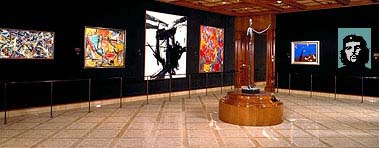
Together We Can Defeat Capitalism
(TWCDC)
Bellagio Gallery of Fine Art
Las Vegas, April, 2000. Website
The guerrilla art collective Together We Can Defeat Capitalism is proud to be showing its work at the Bellagio Gallery of Fine Art in the Bellagio Casino, Las Vegas. We particularly want to thank Steve Wynn, owner of the Bellagio, for his daring and foresight in allowing TWCDC to show its work in a venue that is not normally known to welcome art that questions capitalism.
As Robert Venturi says in his groundbreaking book Learning from Las Vegas, "Learning from the existing landscape is a way of being revolutionary." We hope that the web site that we have prepared especially for our show at the Bellagio Gallery of Fine Art will plant a small revolutionary seed.
To find out more about TWCDC's work you may head directly to our web site powered by the Anti-Capitalist Operating System (ACOS), or you may peruse some samples of work on display here on the Bellagio web site, or read our essay also featured here on the Bellagio web site which gives some philosophical background.
Andy Cox, On the Opening of the TWCDC show at the Bellagio March, 2000
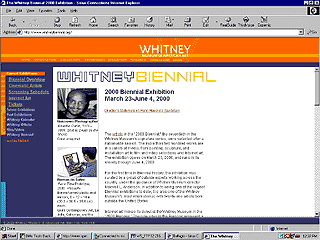
The Whitney Biennial 2000 Exhibition
New York, March 2000. Website Cloning
The Whitney Biennial 2000 Exhibition has been called the "inclusive biennial" because it was organized by six curators from across the USA. TWCDC self-included itself in the exhibition by purchasing the domain name "whitneybiennial.org", copying and altering portions of the Whitney site (www.whitney.org) and reposting the altered portions on the internet under the whitneybiennial.org domain. TWCDC did not alter anything on the original Whitney site, simply enhanced it by adding political commentary. The new altered site is as functional as the original site; you can still even buy admission tickets.
TWCDC, whose mission is to "raise questions about capitalism and have some fun too" believes that much art today has retreated into its shell and fails to engage with some of the scarier issues facing us such as corporate globalization (admittedly, its a big issue to grapple with). Multi-national corporations may be roughly defined as: "highly undemocratic entities produced by the capitalist system and whose mission is to expand the stock-market-as-meaning-of-life orthodoxy across the globe". Still, as we explain in our essay, capitalism can be a lot of fun too: lets face it, there's something very sexy about money and power. It seems that, at least in the West, we are in an age where we can be anything we want. It seems that we want self annihilation. I suppose that's one way defeat capitalism.
In spite of a pervasive nihilism, it is difficult to stand by and watch as the New York Police Department shoots to death the unarmed Amadou Diallo with 41 shots because they thought his keys, or whatever he was groping for in his pocket was a gun. We have included a memorial to him on the website. Society breeds fear so we will all feel safer in shopping malls. Then there's Amadou's fellow citizen mayor Rudolph Giuliani who, we have heard, has added immensely to the quality of life in New York with his mean spirited attitude towards the homeless and other minorities. The website includes a poster idea that he can use in his Senate race.
Andy Cox, On the opening of the 2000 Whitney Biennial
Visit the Whitney Biennial 2000 Exhibition Website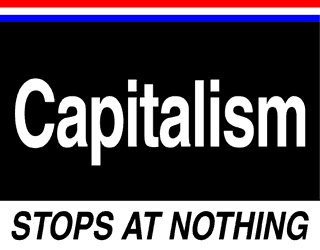
Capitalism Stops at Nothing
San Francisco, July, 1998. Video Insertion,
1302 x 1017 pixels.
In 1998 a San Francisco organization named Together We Can Defeat Capitalism (TWCDC) became a place-based media sponsor for one month. Its founder, Andy Cox, purchased advertising time on the Commuter Channel screens in two stations of the BART system (Bay Area Rapid Transit) - the train system connecting the city to Oakland, Berkeley, and outlying suburbs. TWCDC's "video insertion" was a simple message broadcast silently to waiting passengers several times per hour: the short direct phrase "Capitalism stops at nothing." The slogan was graphically designed to look identical to the institutional announcements that provided passengers with travel information….
…The video seemed to follow Situationist instructions on "how to recycle the detritus of official learning; how to reinscribe texts, figure and artifacts so as to empower them with new meanings; and despite their precautions, how to make new products out of the leftovers of the commodity economy," intertwining political speech with the familiar grind of the everyday - in this case the suspended moment of transit between work and free time, that "television waiting" that so often accompanies waiting in transit spaces… TWCDC's departure from Situationist or Fluxus orthodoxy is indicated in the way that Cox sought to distance the didactic address of the slogan judgmental didacticism of activist modes of address to the public….
…The success of "Capitalism Stops at Nothing" in achieving its goals of promoting discussion and "having fun" is instructive in that it tells us something about the parameters to which media-savvy public activist art must conform. To begin with, it suggests that even though such work exists quite deliberately apart from the commercialized relations of the gallery-based art world, it is an art that must still proceed via an economized decision-making process, one that weighs the price of aesthetic activity in commercial terms. At some point, Cox had to decide whether the piece was worth its $800 price tag, and this decision-making process oriented TWCDC within the reifying logic of capital.
Anna McCarthy, A Geography of Gazes: TV Screens in Public Places (forthcoming)
View a short film about this projectRead an article about this project in Salon Magazine
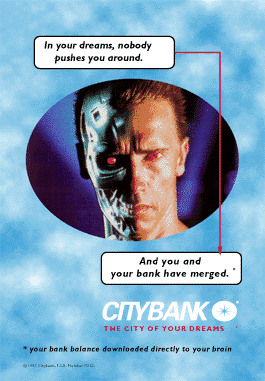
Citybank... In Your Dreams
San Francisco, May, 1997. Guerrilla Advertising Campaign,
dimensions variable.
To talk about different “art” and “advertising” systems is in fact a fiction; rather, we should be talking about systems of power in which ideologies are presented with images and text. There is no outside of this system, unless you want to live in a cave, but even then there’s the possibility of cave paintings. You can complain about this system all you want; but it's not likely to go away any time soon.
Over the past year I have piggy backed on Citibank’s $5 million dollars of market research, psychological analysis, focus groups, art direction, and corporate power. I have created my own advertising campaign for my own dream bank: “Citybank” [sic]. I put people that interested me into my ads: Terminator, Che Guevara, Timothy Leary, Andy Warhol, and Kurt Cobain. Are these my heroes? I don’t know. I heard that there were no more heroes any more. These people, or rather the images of these icons, have all been important to me at some stage for some reason. I have tried to uncover what it is about them and what they represent that interests me, and to formulate slogans for them in my advertising campaign. As a kid, I always wanted to make posters of pop stars and other cultural icons, but I never got round to it. And, I always wanted to be a: rock-star/art-star/psychedelic/revolutionary/machine.
Originally, I thought this project would somehow be a critique of corporate advertising, which would be a critique of the entire system of image/text power in which we live. This now seems an absurd undertaking because, by producing art for public consumption, I am fully implicated in this system. What it has become is an effort to enter into a dialog with the corporate media machine, by inserting my “icons” into the format of Citibank’s advertisements in order to get myself to somewhere else; as Brian Massumi puts it: “The way lies ahead, in taking the inventive potential unleashed by capitalism so far that we become so other as to no longer act in the perceived private interest of a separate Self that we have in any case already ceased to be (if we ever were it).” In other words, this project is part of a never ending exercise in searching for the road to the City Of My Dreams.
Andy Cox, In your dreams, Citybank 1997
Read an article about this project in the San Francisco Bay Guardian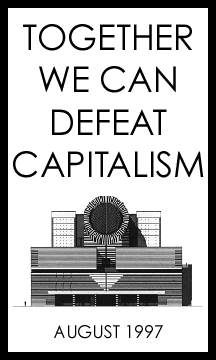
San Francisco Museum of Modern Art
San Francisco, August, 1997. Fliers/postcards/stickers/posters,
dimensions variable.
First came the anonymous postcard. "Together We Can Defeat Capitalism/August 1997" it read, along with a full frontal schematic of the San Francisco Museum of Modern Art. When a sticker version of the message arrived last week, Dog Bites decided to give SFMOMA's PR department a call to get the skinny on the show. "We have no idea of the source of it," said Nina Fallon, a museum spokeswoman. She said someone at the museum thought he saw some stranger putting up stickers around the neighborhood, but their knowledge goes no further.
The ads for the museum's recently closed exhibition "Icons: Magnets of Meaning" had a slick commercial look, and the show celebrated icons such as the BMW 325I, and bluejeans. Perhaps a "defeat capitalism" exhibit would be an amusing antidote.
Phyllis Orrick, San Francisco Weekly August 20-26, 1997
Read the Together We Can Defeat Capitalism FAQ (pdf format)
Comments or questions regarding this website email AndyCox@TWCDC.com
A Together We Can Defeat Capitalism Satire, 2000. All Rights Reserved.